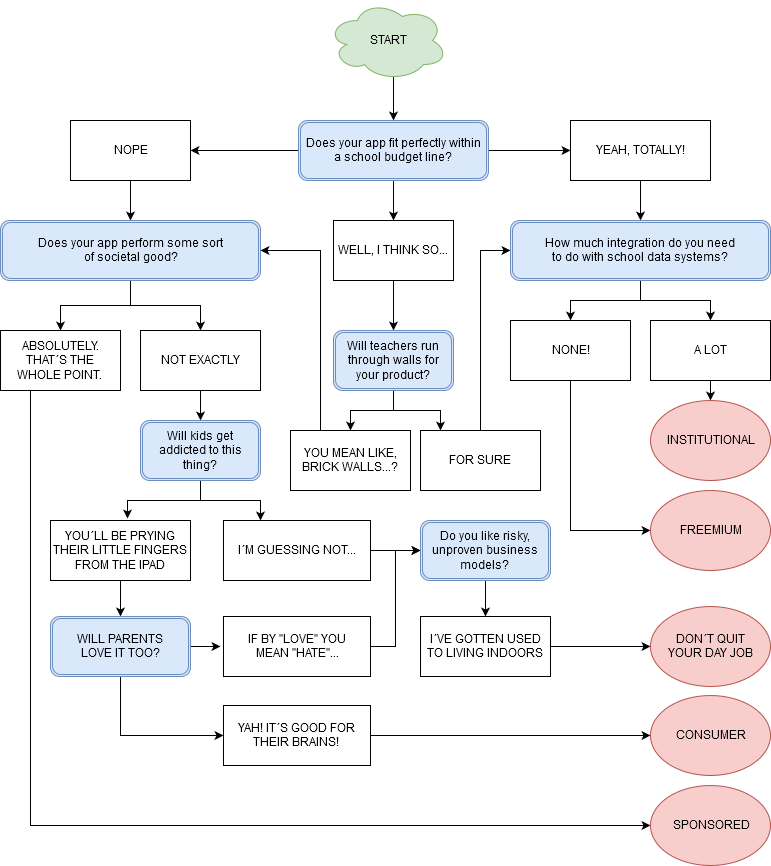by Esteban Sosnik
Dear Esteban,
I have an idea for an edtech product and have started to prototype it and talk to teachers and administrators to see if it’s something they would use. The response seems positive, but I’m totally clueless about how to turn this product into a profitable business. I’ve never worked in the education field, so I need the basics. What are the different business models possible in edtech?
Are You My Model?
Dear Are You My Model?,
I get this question a lot, particularly from entrepreneurs who have not worked in edtech before. There is a general perception that education is full of regulations and red tape that make it impossible to innovate. But I have found that there is a lot of interest from teachers and admins in new digital solutions that “superpower” their work, and edtech companies are finding creative ways to monetize the use of their products.
Many edtech business models resemble business models you see in other industries. Some are somewhat nuanced in the way they work in the education space. Below is a quick summary of four common edtech business models, with an example of a company that is implementing each.
Bottom-Up: Freemium or Free Trial
With this model, teachers can begin using your product for free, with an option to upgrade to a paid version. This can work in two ways: through feature limitations (“freemium “), or time limitations (“free trial”).
The more common freemium model limits the amount of features or support a teacher receives for the free product. And the paid version is essentially a more robust version of the same product. Newsela, a personalized learning tool that allows students to read daily news articles and other nonfiction content at five different reading levels, uses this type of freemium model. The free version of their product gives students access to the daily articles along with comprehension quizzes. And Newsela Pro allows teachers to assign specific articles and to track individual and class-wide progress against Common Core reading and writing standards.
The feature-based freemium model is particularly useful to drive early adoption for products that rely on network effects like Kaymbu or Remind, which are different types of teacher-parent communication tools that require a dense network of adopters for any single user to realize the full value of the app.
With the free trial model, the free and paid versions of the product are identical, but features on the trial version expire after, say, one month. This requires a teacher to convert to the paid version for prolonged use. This model is typically used for products where it is difficult to strip away features from the core offering, and is common with companies that offer content, such as Mystery Science. I think the free trial method really works best when you convince your user to integrate their data into your product during the “free” period. If your app has access to my data — class roster, student grades, or even my calendar or email — and is providing me value by using that data, then I’m locked in, and when the timed trial is over, I convert.
Edtech companies can use these models to execute a bottom-up distribution strategy that targets teachers for users but tries to monetize at the school or district level. Here, teachers can begin using the product for free and ultimately you (or the teachers themselves!) can convince the administrators to buy the enterprise version of the product for the entire school or district. In the best case, teachers become your de facto sales reps as they pitch the product to their site or district administrators who control the budget. Ilya Fushman’s excellent post about the growth of Slack using this freemium model closely parallels the ideal case for edtech companies.
The great advantage of this model is that you can gain traction quickly and distribute your product straight to your end user without intermediaries. The main disadvantage is that in education you have a classic principal-agent problem (pun intended) — your users and your buyers are generally not the same. If you design focusing mainly on the economic buyers (principals, administrators), your product might not be as compelling to your end users, the teachers. On the flip side, teachers might love and use your product but lack the influence to get their schools to purchase it, or the budget to pay for it themselves. This is where smart companies create tools and strategies for teachers to approach their administrators, essentially coaching teachers on available funding sources and how to position the product to admins.
Overall, freemium and free trial products need to be simple for teachers to adopt and put to use in their classrooms, and the free version of the app should provide clear value to the teacher.
Institutional
This is the more traditional model of selling to schools through district leaders. The sales strategy is generally referred as “top-down,” meaning a district makes a purchase for all the schools under its administration. In most cases, the product license is used only by a subset of schools or teachers, but districts tend to buy licenses for all their schools to guarantee equal access to resources. The main advantage of an institutional business model is that districts are positioned to sign large contracts. The main disadvantage is that these contracts take a long time to close, and usually involve competing with other vendors in the “Request For Proposal” (RFP) process. Districts can be demanding customers in terms of compliance and customer service.
This is the best approach for edtech companies that need to integrate into school- or district-wide data systems, or whose users are going to be school administrators. Schoolzilla provides K-12 districts with a secure, hosted data warehouse and customizable dashboards that bring school data into focus for teachers, principals, and district leaders. It is principals and administrators who get day-to-day value from Schoolzilla, so it makes sense to sell to them. Plus, the very nature of a product like this necessitates an institutional business model; a single teacher can’t use Schoolzilla without a school- or district-wide implementation.
In the institutional model, it is highly advantageous to have impact metrics available — ideally a convincing randomized controlled trial (RCT) result. It is also key to have a deep understanding of district budgets, what line item(s) match your product, and who the different stakeholders are in that vertical.
Consumer
The consumer approach is an emerging business model that allows schools to use a product for free, and then charges families if they want to continue usage at home. This model is suited to companies with products that kids can use on their own. Schools, in this case, essentially become lead generation (or “lead gen”) for consumer adoption.
With this model, it is important to create a “product loop” between school and home, where teachers use the product with kids in school and then also recommend to parents that students continue using the product at home. The advantage of this model is that schools love free (quality) products, which can drive user adoption, and parents tend to listen to teachers’ recommendations for what tools to use at home. This is a great way to establish a trusted brand, as Scholastic has proven.
ABCmouse provides educational games and activities to young children on a subscription basis and sells directly to parents. They also offer their content to teachers, Head Start programs, public libraries, and other community organizations for free. As an impact investor, I like this model: On the impact side, it serves a social mission by reaching a student population that may not otherwise be able to afford these resources. On the investor side, distributing to schools for free is a cost effective way to make parents aware of your product.
The disadvantage of this model is that, at least in the US, it is not always easy to monetize consumers for supplemental educational content. For more on this point, check this post about the difficulties of the educational games market. Another disadvantage is that this model can be inequitable, with students from more wealthy backgrounds able to afford educational tools that their lower income peers cannot.
In the consumer model your value offering should focus on engagement for kids and a clear value proposition for parents.
Sponsored
Finally, a less common, but quite interesting model is one where neither schools nor parents pay. Instead corporate or foundation sponsors pay for product placement, usually as part of a corporate social responsibility (CSR) initiative. Sponsors could be banks (usually credit unions) that are required to invest in financial literacy education, or hospitals and healthcare companies that are required to spend money to promote healthy living. The advantage of this model is that the sponsor will care mostly about usage, which is likely to be quite high if you’re offering a quality, free product to schools.
With sponsored models, it’s key that there is alignment between your app and the mission or philanthropic goals of your sponsor (intrusive advertising is a big no-no in schools). The difficulty is that there is not always an obvious sponsor for your app, or there may be very limited options for sponsors who are directly connected to your mission.
GoNoodle provides teachers with a library of “brain break” videos that help get young kids active, creative, and moving around. Because their app promotes children’s health, they developed a partnership model with hospitals and health plans, and even national brands like Finding Dory. The sponsors improve their brand image and visibility by providing GoNoodle to a community for free, and GoNoodle tracks and reports on the social impact of the sponsor’s funding.
Which Edtech Business Model is Right for You?
You should think about which of these models fits you best based on your product characteristics. You can also consider combining two of the models to fit your product and business needs. For example, a company with a freemium model for schools might need to do an institutional sale for a large district. The data from freemium users can help close the district deal, a unique advantage of a blended freemium/institutional approach.
We encourage you to be creative and find new ways to innovate with monetization and distribution, particularly as schools are becoming more open to different models of tech adoption. As the monetization guru Madhavan Ramanujam points out, sometimes the best product innovation is the monetization model itself.


